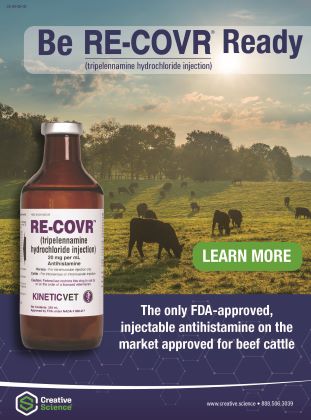Keeping Cattle Cool: Top Tips for Comfort at Peak Summer Heat

Keeping Cattle Cool: Top Tips for Comfort at Peak Summer Heat
Article and photo courtesy of Central Life Sciences
As summer temperatures soar, cattle producers face the annual challenge of keeping their herds comfortable in the scorching heat. Cattle can experience stress due to their limited ability to cool down through sweating the way humans do. Cattle rely on respiration to stay cool, and have to work harder to stay cool in the summer, especially when the heat of the day climbs above 80 degrees. And it isn’t just a matter of general discomfort – the stress high temperatures put on cattle can lead to decreased breeding efficiency, lower milk production, dehydration, heat exhaustion, compromised immune systems and unhealthy weight gains.
It’s crucial to keep cattle cool during hot weather to maintain their health and to avoid a negative impact on your bottom line. Fortunately, there are effective strategies for ensuring your cattle stay cool and healthy during the hot summer months. Here are the top ways to manage cattle comfort in the heat:
- Provide Plenty of Shade and Increase Airflow
Having shaded areas available for cattle to shelter is crucial, and is especially important to consider for cattle with darker coats that absorb more heat. Making sure cattle have access to trees, open sheds, or covered structures will help offer relief from direct sunlight. When cattle must be sheltered in enclosed barns, ensure that ventilation systems are functional, and consider adding fans to increase airflow.
- Maintain Clean and Dry Bedding
Rest is essential to keeping cattle comfortable, so maintaining clean and dry bedding is mission critical. If not properly managed, however, bedding can quickly become a breeding ground for flies, an added problem for cattle seeking rest in hot temperatures. Regularly cleaning and replacing bedding will help keep it dry and free from contaminants. This will not only help with cattle comfort but will also have the added benefit of reducing the risk of fly infestations.
- Keep Cattle Well-Hydrated
Just like with humans, hydration is a must during the summer. Cattle will require even more water to stay hydrated. Ensure a constant supply of clean, fresh water, and regularly check for contaminants like debris or excrement. Make sure to place water sources in shaded areas and consider insulating water pipes to keep the water cool.
- Adjust Feeding Times to Account for Heat
Heat is an appetite suppressant, so cattle are less likely to feed properly during the hottest parts of the day. To help ensure they maintain their feed intake, schedule feeding times during cooler periods, such as early morning or late evening. This adjustment can help avoid heat stress and maintain productivity.
- Monitor for Heat Stress
Recognizing the signs of heat stress early can prevent serious health issues for your cattle. In the hottest days of summer, however, some heat stress may be unavoidable, so be on the lookout for symptoms. Signs of heat stress in your cattle could include elevated breathing rates, drooling, open-mouth breathing, restlessness, or cattle grouping together. The USDA Agricultural Research Service identifies six stages of heat stress, ranging from mild to severe. Understanding these stages helps you respond quickly and effectively:
- Breathing rate starts to increase, cattle seem agitated, and they spend more time on their feet.
- Breathing rate continues to rise, a slight amount of drooling may be noticed, with most animals becoming agitated and staying on their feet.
- Breathing rate is notably higher, drooling or foaming at the mouth is more pronounced, with a majority of cattle showing signs of restlessness and starting to gather in groups.
- Breathing rate is high, cattle begin breathing with their mouths open, and most of them are standing and might cluster together. Some drooling is visible.
- Breathing becomes more intense, with cattle pushing from their sides, breathing through open mouths with their tongues sticking out, and possible drooling. Cattle are likely to be restless and standing.
- Cattle breathe heavily with their mouths open and tongues protruding. Breathing becomes labored, with a decrease in respiration rate. Cattle may push from their sides when breathing, hold their heads down, and possibly separate from the herd.
- Implement an Integrated Pest Management Program
Flies can be a significant problem during summer, leading to reduced feed efficiency and potential health issues. An Integrated Pest Management (IPM) program helps control fly populations through a combination of approaches:
- Regularly clean and dispose of decaying organic matter, such as manure and spoiled feed, to eliminate fly breeding grounds.
- Encourage natural predators like dung beetles and parasitic wasps.
- Use fly traps and sticky tapes to capture adult flies and reduce their numbers.
- Apply insecticides and insect growth regulators (IGRs) to target adult flies and prevent larvae from developing.
These combined methods can significantly reduce fly-related stress and promote cattle health.
By following these tips, you can help ensure that your cattle remain comfortable, healthy, and productive throughout the summer. It’s essential to stay vigilant, monitor your herd for signs of heat stress, and adjust your management practices as needed to maintain optimal conditions for your cattle.
For more information on cattle comfort and fly control strategies, visit CentralFlyControl.com.
1 USDA’s Agricultural Research Service




